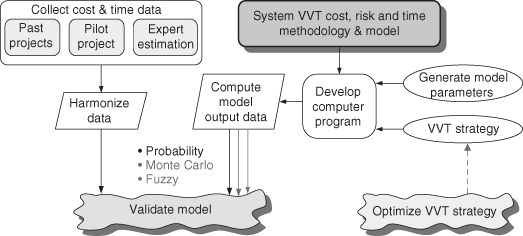8.1 METHODOLOGY VALIDATION USING A PILOT PROJECT
In this chapter we describe the validation of the methodology for estimating VVT cost, time and risks. Methodology validation is illustrated by means of an industrial pilot project development conducted at the Lahav division of the Israel Aerospace Industries (IAI) during the timeframe 2003–2004. Figure 8.1 depicts this process. The IAI/Lahav typical avionics upgrade Anchor system and VVT data were created from (1) records of past projects, (2) data gathered during the pilot project itself and (3) estimates made by domain experts by means of a Delphi process.
However, the VVT cost, time and risk model database was created by relevant VVT data obtained from current literature and domain experts. Additionally, the VVT strategy representing the one used during the pilot project was employed. The VVT estimation model embodied in the VVT-Tool was executed. Then, the computed VVT model output was compared with the anchor VVT data and was found to be quite similar. The above procedure was carried out using an initially probabilistic paradigm and then a fuzzy logic paradigm. This chapter describes the validation of the VVT cost and time models as well as the validation of the fuzzy VVT cost model.
Figure 8.1 VVT methodology validation and VVT strategy optimization.

8.1.1 VVT Cost Model Validation
Anchor VVT Cost Results
The overall ...
Get Verification, Validation, and Testing of Engineered Systems now with the O’Reilly learning platform.
O’Reilly members experience books, live events, courses curated by job role, and more from O’Reilly and nearly 200 top publishers.

